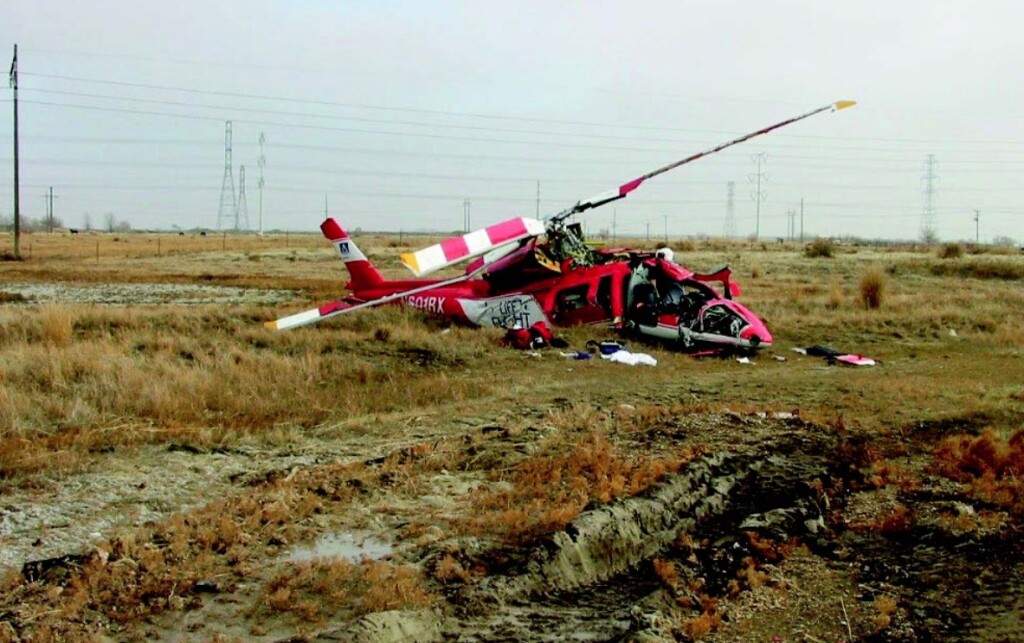Life Flight 6 – US HEMS Accident (A109K2 N601RX)
On 10 January 2003, Helicopter Emergency Medical Service (HEMS) Agusta A109K2 N601RX, operated as Life Flight 6, was lost in a fatal accident in Salt Lake City, Utah in poor weather at night. The helicopter was owned and operated by IHC (Intermountain Health Care) Health Services, Inc.
The US National Transportation Safety Board (NTSB) reported that:
While maneuvering low to the ground during night conditions, the air ambulance helicopter encountered fog and poor weather conditions, and impacted the terrain. Shortly after departing from its hospital base, the helicopter was cleared by air traffic control to proceed through a major airport’s airspace to respond to a medical emergency.
After crossing through the airspace, the pilot elected to abort the mission; however, he was instructed by air traffic control to hold and wait for clearance through the airspace due to landing traffic at the airport. After holding for approximately 10 minutes, the pilot stated, “I’m basically inadvertent IMC at this time and declaring emergency…I’m currently on a heading one five zero.”
Examination of the accident site revealed the helicopter impacted the terrain on a heading of 150 degrees, became airborne for approximately 1/4 mile, then impacted the terrain and came to rest upright in a grassy field. Examination of the helicopter revealed no evidence of an in-flight control or system malfunction prior to the initial impact.
Prior to the accident helicopter’s departure from the hospital base, another air ambulance company helicopter attempted the same mission; however, aborted the mission due to fog and deteriorating weather conditions.
The pilot and one of the medical personnel aboard were killed and another medic received serious injuries.
The NTSB determined the probable cause of the accident to be:
The pilot’s delayed remedial action and continued flight into known adverse weather conditions which resulted in his failure to maintain clearance with the ground. Contributing factors were the prevailing fog, and the pressure to complete the mission induced by the pilot in command as a result of the air ambulance operation.
An excellent candid educational video case study on this accident was produced that discussed ‘helicopter shopping’, a practice where hospital dispatchers call multiple operators when one turns down a flight for weather reasons. It also discussed the aftermath of the accident and the powerful emotional effects of a fatal accident. UPDATE: That video was online in 2015 but unhelpfully has since been withdrawn.
Safety Resources
UPDATE 10 February 2016: Following US NTSB Board Member Robert Sumwalt’s recent HEMS article in Professional Pilot, we thought we’d take a look at how the US HEMS accident rates have changed over the last decade: US HEMS Accident Rates 2006-2015
UPDATE 24 December 2016: Dr Ira Blumen, program/medical director for the University of Chicago’s Aeromedical Network (UCAN) has been tracking US HEMS safety performance since 2000. A recent report based on his data noted:
In 1980, a HEMS crewmember had a 1 in 50 chance of being in a fatal accident; today that number is 1:850. From 1972 to 2016 there were 342 helicopter EMS accidents…123 of those 342 resulted in at least one fatality. Some 1,053 personnel were involved in those accidents; 328 died, 116 sustained serious injuries, 136 had minor injuries and 473 were uninjured… [meaning] 68.8 percent survived Unfettered competition has allowed the nation’s HEMS fleet to mushroom from 151 aircraft in 1986 to 309 in 1996 to 648 in 2006 to 852 today. If you add in dual-purpose aircraft, the number is 979, and it could be as high as 1,048 if you count non-operational spares. [However] “This is the first year ever there has been a contraction in the number of helicopters,” Blumen said.
…the average aircraft flew 800 hours in 1994 and 600 hours between 2003 and 2008, at which time flying dropped precipitously after the accidents of 2008 and the ensuing negative publicity. “People said, ‘We are not sending our patients in helicopters,’” Blumen noted. Now the number of flight hours per helicopter is moving up again, averaging 490 in 2016.
2008 VIDEO on helicopter shopping:
The European Safety Promotion Network Rotorcraft (ESPN-R) has a helicopter safety discussion group on LinkedIn. You may also find these Aerossurance articles of interest:
- UPDATE 26 May 2018: US Fatal Night HEMS Accident: Self-Induced Pressure & Inadequate Oversight Four died when Metro Aviation Airbus Helicopter AS350B2 N911GF suffered a loss of control due to spatial disorientation after taking off into night instrument meteorological conditions from a remote site.
- UPDATE 10 June 2018: Italian HEMS AW139 Inadvertent IMC Accident We look at the ANSV report on a HEMS helicopter Inadvertent IMC event that ended with an AW139 colliding with a mountain in poor visibility.
- UPDATE 29 September 2018: HEMS A109S Night Loss of Control Inflight
- UPDATE 2 January 2020: EC130B4 Destroyed After Ice Ingestion – Engine Intake Left Uncovered
- UPDATE 5 March 2020: HEMS AW109S Collided With Radio Mast During Night Flight
- UPDATE 19 April 2020: SAR Helicopter Loss of Control at Night: ATSB Report
- UPDATE 26 September 2020: Fatal Fatigue: US Night Air Ambulance Helicopter LOC-I Accident
- UPDATE 23 January 2021: US Air Ambulance Near Miss with Zip Wire and High ROD Impact at High Density Altitude
- UPDATE 31 January 2021: Fatal US Helicopter Air Ambulance Accident: One Engine was Failing but Serviceable Engine Shutdown
- UPDATE 21 August 2021: Air Methods AS350B3 Night CFIT in Snow
- UPDATE 15 January 2022: Air Ambulance Helicopter Struck Ground During Go-Around after NVIS Inadvertent IMC Entry




Recent Comments